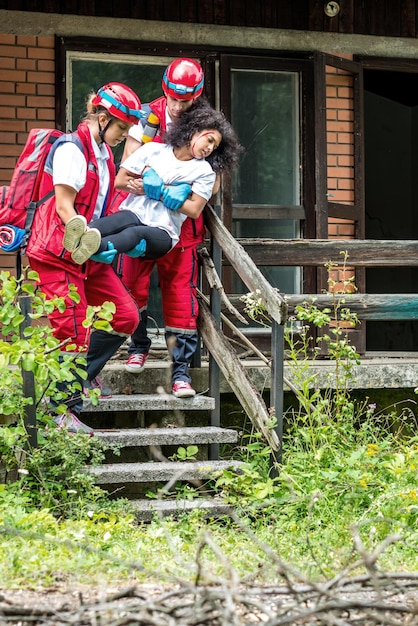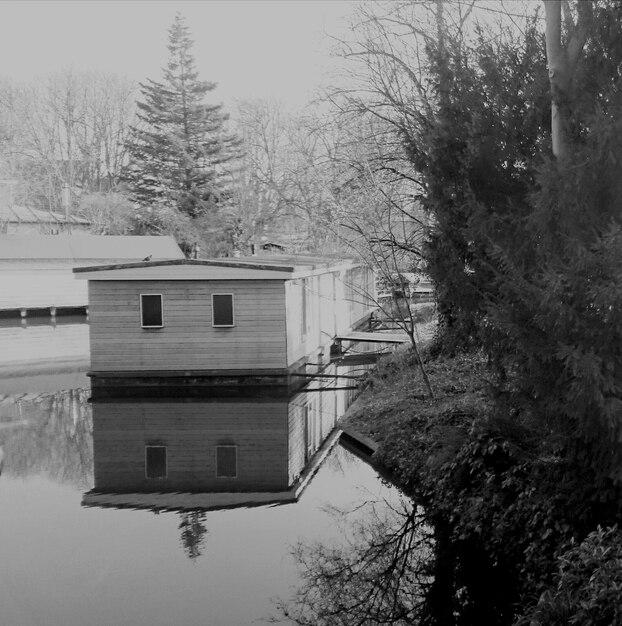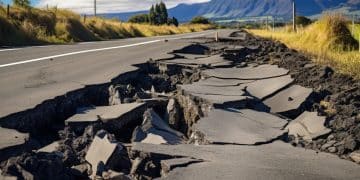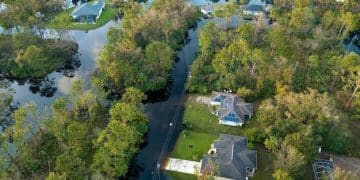Evacuation Strategies: Plan Your Disaster Escape Route in the US

Evacuation strategies are crucial for ensuring safety during disasters, emphasizing the need for personalized plans, community awareness, and adaptable routes in the US.
In the face of potential disasters, having well-defined evacuation strategies: planning your escape route in case of a US disaster is paramount. This article outlines how to craft an effective escape blueprint.
Understanding the Landscape of US Disasters
The United States faces a multitude of potential disasters, ranging from natural events like hurricanes and earthquakes to man-made crises. Understanding the specific risks in your region is the first step in formulating effective evacuation plans.
The potential disasters vary greatly based on location. Residents of the Gulf Coast must prepare for hurricanes, while those in California need to be ready for earthquakes. In the Midwest, tornadoes are a primary concern. Recognizing these regional threats allows for tailored preparation.
Common Types of Disasters in the US
Here’s a closer look at some prevalent disasters across the US. Understanding the nature of each threat informs the design of appropriate evacuation strategies.
- Hurricanes: Characterized by strong winds, heavy rainfall, and storm surges, prompting coastal evacuations.
- Earthquakes: Sudden ground shaking requires immediate evacuation from unstable structures.
- Wildfires: Rapidly spreading fires necessitate swift evacuation from affected areas to avoid smoke inhalation and direct flames.
- Floods: Rising water levels can isolate communities, demanding timely evacuation to higher ground.
Being informed about the types of disasters that might affect your community allows for better preparation and specific strategies tailored to each type. This proactive approach significantly increases your safety during a crisis.

In conclusion, the initial stage of any robust evacuation strategy involves a thorough awareness of the potential disaster types specific to your location, ensuring that you can prepare and respond appropriately.
Creating a Personalized Evacuation Plan
A one-size-fits-all approach doesn’t work for evacuation planning. A personalized plan takes into account your specific needs, location, and resources. Creating such a plan is crucial for ensuring your safety and that of your family.
Your personalized evacuation plan should start with identifying your home’s vulnerabilities and considering external factors. This encompasses everything from your physical limitations to the availability of transportation.
Key Components of a Personalized Plan
Effective plans incorporate several critical components. These include assessing risks, establishing communication protocols, and preparing for contingencies.
- Identify Escape Routes: Plan primary and alternative escape routes from your home and neighborhood.
- Establish a Meeting Point: Designate a safe meeting place outside your immediate area in case family members get separated.
- Pack a Go-Bag: Assemble a kit with essentials like water, food, medication, and important documents.
- Practice Drills: Regularly conduct evacuation drills to familiarize all family members with the plan.
By incorporating these elements, you’re taking substantial steps toward ensuring a safe and efficient evacuation. Regular reviews and updates are also essential, especially as family circumstances change.
Ultimately, a personalized evacuation plan is a cornerstone of disaster preparedness. Tailoring it to your specific circumstances ensures you are ready to act decisively and effectively when a disaster strikes.
Assessing Your Home’s Vulnerabilities
Every home has unique vulnerabilities that can impact safety during a disaster. Identifying and addressing these risks is a crucial step in developing an effective evacuation plan. Understanding your home’s weak points enables you to make informed decisions about evacuation strategies.
Start by evaluating the structural integrity of your home and its surroundings. Factors like the age of the building, its construction materials, and the landscape around it all play a role.
Identifying Potential Hazards
Hazard identification involves recognizing risks both inside and outside your home, which could impede evacuation or cause additional harm.
Consider the risks posed by downed power lines, which can block routes or cause electric shock. Also, evaluate the potential for flooding in your area, looking at past flood events and local geography.
In addition, determine whether your home is in an area prone to landslides or mudslides. These events can make evacuation routes impassable, trapping you and your family.
Completing a comprehensive risk assessment will provide a clear picture of the challenges you might face. This knowledge is essential for creating an evacuation strategy that accounts for your specific circumstances.

By pinpointing potential hazards, you can develop tailored strategies that mitigate these risks. This proactive approach improves your chances of a safe and successful evacuation.
Establishing Communication Protocols
Effective communication is paramount during a disaster. Establishing clear communication protocols within your family and with local authorities can be a lifesaver. In the chaos of an evacuation, pre-arranged communication strategies can ensure everyone stays informed and connected.
The cornerstone of any communication plan is identifying primary and secondary contact methods. These methods should account for the possibility of power outages or disrupted cell service.
Key Communication Strategies
Here are some critical communication strategies to incorporate into your evacuation plan:
- Designate an Out-of-State Contact: Choose someone outside your region to serve as a central communication hub.
- Share Critical Information: Ensure everyone knows important phone numbers, meeting points, and evacuation routes.
- Utilize Communication Apps: Apps like WhatsApp or Signal can facilitate communication even when phone lines are down.
- Invest in a Weather Radio: A NOAA weather radio provides timely alerts about potential disasters.
Creating and practicing these communication strategies can reduce confusion and panic during an evacuation. This preparation increases your efficiency and likelihood of a safe outcome.
In summary, a solid communication plan is an essential element of any successful evacuation strategy. It ensures that you and your loved ones can stay in touch and coordinate effectively during a crisis.
Assembling a Comprehensive “Go-Bag”
A “go-bag” is a portable kit containing essential supplies needed for survival during an evacuation. Having a well-stocked “go-bag” ensures you have immediate access to necessities, providing comfort and security in a stressful situation.
The contents of your “go-bag” should be tailored to your specific needs but generally include items for sustenance, health, and communication. Prioritize items that can sustain you for at least 72 hours.
Essential Items for Your Go-Bag
Here’s a list of must-have items to include in your evacuation “go-bag”:
- Water: At least one gallon per person per day for drinking and sanitation.
- Food: Non-perishable items such as canned goods, energy bars, and dried fruit.
- First Aid Kit: Include bandages, antiseptic wipes, pain relievers, and any personal medications.
- Flashlight and Batteries: Essential for navigating in the dark.
In addition to these basics, consider including copies of important documents, a portable charger for your phone, and some cash in small denominations. These items can be invaluable when traditional resources are unavailable.
Remember, the key to an effective “go-bag” is being prepared but also keeping it manageable. Periodically review and update the contents to ensure everything is still usable and relevant to your needs.
In summary, a comprehensive “go-bag” is an indispensable tool in your evacuation plan, providing essential resources that can greatly improve your safety and comfort during a disaster.
Practicing Evacuation Drills
Practicing evacuation drills is a critical component of disaster preparedness. Regular drills ensure that all family members are familiar with the evacuation plan and know exactly what to do when a real emergency occurs. The more you practice, the more instinctive your response will become.
Start by scheduling drills at different times and under various simulated conditions. This will help you identify potential weaknesses in your plan and make necessary adjustments.
Conducting Effective Drills
Here are some tips for conducting realistic and effective evacuation drills:
- Simulate Different Scenarios: Practice evacuating under various conditions, such as during the day, at night, or during simulated power outages.
- Time Your Drills: Measure how long it takes to evacuate to identify areas where you can improve efficiency.
- Involve All Family Members: Ensure everyone, including children and elderly relatives, participates in the drills.
- Evaluate and Adjust: After each drill, discuss what went well and what could be improved, and adjust your plan accordingly.
Moreover, integrate these drills into your routine to keep your household prepared for a real-world scenario. Regular execution reinforces the safety practices you need in a disaster.
To conclude, the habit of running recurring evacuation drills is a proactive strategy that improves your family’s readiness and efficiency during life-threatening emergencies.
| Key Point | Brief Description |
|---|---|
| ⚠️ Assess Risks | Identify potential hazards in your area, like floods or wildfires. |
| 📍 Plan Routes | Establish primary and alternative evacuation routes. |
| 🎒 Pack Go-Bag | Prepare a kit with water, food, and essential supplies. |
| 📞 Communicate | Set up a family communication plan with a contact outside your area. |
FAQ
▼
An evacuation strategy ensures safety during disasters, minimizing risk of injury or loss of life by providing a structured and prepared response.
▼
It is advisable to conduct evacuation drills at least twice a year to keep the plan fresh and ensure everyone remembers their roles.
▼
A basic “go-bag” should include water, non-perishable food, a first aid kit, flashlight, batteries, and copies of important documents.
▼
Assess your home’s location, structure, and surroundings for potential hazards, like flood zones or areas prone to wildfires or earthquakes.
▼
An out-of-state contact person can serve as a central communication point in case local communication lines are disrupted during a disaster.
Conclusion
Creating comprehensive evacuation strategies: planning your escape route in case of a US disaster ensures readiness and safety. By personalizing plans, assessing vulnerabilities, establishing communication protocols, preparing “go-bags,” and conducting regular drills, individuals and families can significantly enhance their ability to respond effectively during crises throughout the US.





